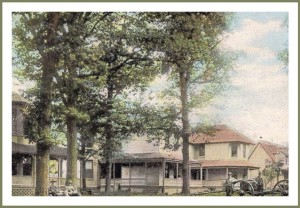
I’m excited about the installation of permanent outdoor signs on VMFA’s campus that interpret the history of the Confederate Soldiers’ Home—a residential compound for poor and infirm southern veterans that once stood on the site between 1885 and 1941. Established by R. E. Lee Camp, No. 1, Confederate Veterans, the camp included, among many buildings: nine bungalows, a large barracks, dining hall, hospital, recreation hall, and a park-like commons. At peak occupancy, residents numbered just over three hundred; altogether a total of nearly three thousand veterans from thirty-three states called the camp home. Today, three buildings survive from the camp era: the earlier Robinson House (known then as Fleming Hall), the Home for Needy Confederate Women (now VMFA’s Pauley Center), and the Confederate Memorial Chapel. In the mid-20th century, the Commonwealth of Virginia gained ownership of the property and designated the site as the Confederate Memorial Park.
We’re hoping that our visitors—including those coming during the city-wide “Civil War and Emancipation Day” commemoration on April 16th—will find the history of the museum grounds as compelling as we do. In researching the story, I learned about Anthony Robinson Jr., who built the ca. 1855 farmhouse that still stands, now just opposite the museum’s new entrance. As we celebrate the emancipation of enslaved people, my thoughts go to the African Americans listed as property in Robinson’s 1861 will—people who undoubtedly toiled upon this land.
And in remembering the Civil War, the site brings a somber recognition of national schism, war, and the physical and mental toll upon its survivors. But it also reminds us of post-war healing and reconciliation, as the camp was built and supported with funds donated by former Confederate and Union soldiers alike.
During “Civil War and Emancipation Day” on April 16th, sponsored by the Future of Richmond’s Past, other VMFA activities will include a 1:30 tour of the former Home of Needy Confederate Women and self-guided viewing of Civil-War related artworks within the museum, including the iconic Burial of Latané by William D. Washington (1864, lent by the Johnson Collection). Free shuttle buses will be available through the day to transport visitors to the multiple historic sites in Richmond commemorating the 150th anniversary of the Civil War and the end of American slavery. For more information about the day, go to http://civilwar.emancipationday.net/.
–Elizabeth O’Leary, Associate Curator of American Art